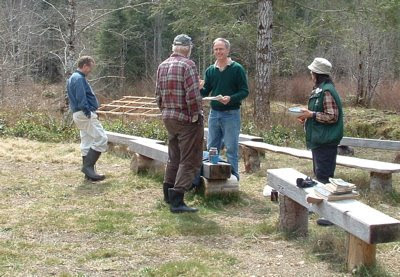
When I lived in Egmont 25 years ago it was a fishing village. The locals fished commercially right in front of our cabin in Boiler Bay. Our dietary staples were salmon, clams, oysters and rockfish. When the fishboat was out we rowed into town to Bathgate’s Store, or hiked in on the trail that goes to the Skookumchuk Rapids. The kids did school by correspondence, and later attended the Egmont one-room school. Favourite outings were to the Egmont Thrift Store next to the little Post Office, and seasonal celebrations in the Community Hall. All our neighbours were down-to-earth and resourceful. Vera Grafton, First Nations elder and whafinger regularly rowed over to look in on us.
There haven’t been any commercial salmon openings Jervis Inlet for decades now, and the kids bus to school in Pender Harbour; but that may be all that’s changed, really. There’s a plaque for Auntie Vee on the Egmont dock. The locals still harvest seafood, and do just about anything else that’s possible. Whether a fishing village has to turn to tourism or recreational property is still an open question here. What I see in Egmont is people making a living as they can, while still in touch with their surroundings - animal and human neighbours, forests, tides, weather, environmental concerns. There is some of the worst logging I’ve ever seen scarring the whole mountainside above the gravel pit – and the pit has become much more of an eyesore since I lived here. And yet it’s beautiful in Egmont. Maybe because it’s rural, sort of forgotten about, human life is in perspective with all the other creatures.
We come to Egmont to go up on Billy Griffith’s marine ways.
Billy built his seine boat Tzoonie River in the early 70’s. He’s a good fisherman, and Tzoonie River is often one of the high catch boats in the commercial salmon openings out of Prince Rupert, but Billy is most proud of awards for best by catch recovery levels. He and other family members are active in the local salmon enhancement program. Right now he’s getting ready for the local prawn season. His son Johnny sold his seiner in the buy-back and is a computer expert in the lower mainland, but Billy’s grandson Michael is fast learning about boats.
Michael’s mom, Maureen invited Thomas and I to hold a session on “Foraging” at the Iris Griffith Nature Centre. Iris was Billy’s late wife and leader in environmental concerns on the Sunshine Coast for many years. At the beautiful, peaceful centre with the sounds of frogs, birds and ducks all around us, interested people shared their knowledge and experience with local wild plants.
 drying wild onions
drying wild onions stinging nettles, a prized spring green
stinging nettles, a prized spring green Foraging discussion at Iris Griffith Nature Centre
Foraging discussion at Iris Griffith Nature CentreWhy foraging? Why gather wild food? Spiritually, to be intimately in touch with where we are, fed by the nourishing gifts of nature. For health. For those trying to move towards the 100 mile diet you can hardly get closer than your local dandelions. And in economic/political terms, well, Maureen gave me a button to wear: “Be Subversive, Buy Local Food”
I kept thinking “Iris would have loved this gathering!”
 Learn more at this link:
Learn more at this link:www.lagoonsociety.com
Maureen also invited us to join her family for one of their regular beach walks. Adults and children spend hours looking at the neighbours.
Michael complains that his science class at school is boring – but the highlight of his week is “Lagoonies”, the after school nature study at the Iris Griffith Centre.
Some “Egmonsters” are newcomers, it’s been home for others for generations. I recognize cabins and boats from 25 years ago. We were tied beside decades of history in the boats people have left behind. And among the old, new life.
Three classic boats
The swan is a classic tugboat built in 1907. It’s present owners Chris and Christina are giving it a new chapter of life, after all the stories of its many adventures. Chris says you can read its history on the internet. (Google something like Swan 1907)Tom, the former owner of Swan, came to Egmont as manager of the new museum. He is now lovingly restoring The Widow Brown.
There’s another new/old neighbour in the waters around Egmont. Henry the humpback whale is regularly seen, and heard. We saw our first humpback in Georgia Straight 2 years ago near the mouth of Jervis Inlet. There haven’t been any humpback whales in Georgia Strait since 1903, when the whole population of 99 humpbacks were hunted and killed, processed in Nanaimo. And now, finally, they are coming back. Henry is very welcome!
Last year we saw Ralph the seal, and heard about his friend Serena. These two orphaned seals were rescued and bottle fed on ground herring and milk. Later the kids caught shiners off the dock and put them in an inflatable swimming pool so the seals could learn to catch their own food. The seals visit their human friends regularly.
On La Sonrisa we love to trade. We traded crab for some organic Canadian grain and beans. But when the crab started clicking, like they do, in their bucket, Paul thought they were laughing and he couldn’t cook them. One of them, Harold, became Michael’s pet. He put him on a string and takes him for walks on the sea bottom.
Of course we had to offer our old crab bait for Harold’s food. And he needs a lot of watching, so humans have to spend a lot of slow time on the dock and shore. But Michael is sad to report that Harold has escaped – he’s somewhere between Henry and Ralph, enjoying the waters of Egmont.






























